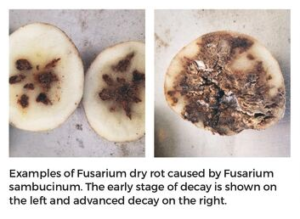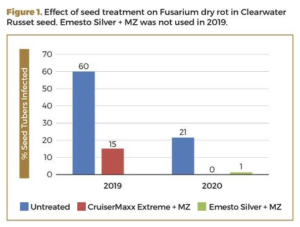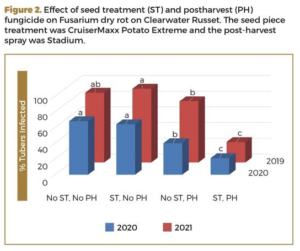
Beating back Fusarium dry rot in Clearwater Russet
Clearwater Russet offers many advantages to potato growers as a dual-purpose russet cultivar. It produces a high percentage of U.S. No. 1 tubers and has a low incidence of sugar ends and cold-induced sweetening.
 The Achilles’ heel of this variety is a relatively high susceptibility to Fusarium dry rot. Dry rot has caused both seed decay issues as well as stored crop decay and breakdown. The high susceptibility of Clearwater has caused some growers to increase the seed planting rate per acre due to seed-piece decay issues.
The Achilles’ heel of this variety is a relatively high susceptibility to Fusarium dry rot. Dry rot has caused both seed decay issues as well as stored crop decay and breakdown. The high susceptibility of Clearwater has caused some growers to increase the seed planting rate per acre due to seed-piece decay issues.
Multiple management practices necessary to manage Fusarium dry rot on seed include:
- Purchasing seed with as little dry rot as possible. Examining seed in storage or a sample from potential seed sources will help reveal the degree of Fusarium infection from harvest injuries.
- Treating with an effective seed treatment.
- Planting uncut seed when possible.
- Sharpening the cutting knives to reduce tuber cell injury.
- Reducing the time between cutting and planting, unless seed is properly suberized and managed. Lengthening the time between cutting and planting without curing conditions can give the Fusarium fungus a head start on decay.
- Sterilizing seed cutting equipment between seed lots.
- Avoiding planting into cold soil temperatures or planting cold seed into warm soil temperatures.
Additional measures for management harvest include:
- Minimizing wounding. Avoid cooler pulp temperatures at harvest which favor shatter bruise. This variety is also very sensitive to any physical impact, so use care to minimize drops and pad all areas where an impact may occur.
- Application of a post-harvest fungicide where allowed.
- Creating good wound healing conditions in the initial days of storage.
Fusarium needs a wound to infect and many operations at planting and harvest wound the potatoes. For varieties like Clearwater with a high level of susceptibility, care and attention to these guidelines is critical.
A research project was sponsored during the 2019 and 2020 growing seasons by the Northwest Potato Research Consortium aimed at evaluating the susceptibility of different varieties to Fusarium dry rot. This article will focus on the seed treatment and post-harvest fungicide use for Fusarium control specific to Clearwater Russet.
Use an effective seed treatment
Seed pieces were inoculated with an isolate of Fusarium sambucinum, the most common Fusarium species isolated from potatoes in southern Idaho. Immediately after inoculation, seed pieces were treated or not treated. In 2019 the treatment was CruiserMaxx Potato Extreme (0.31 fl oz/cwt) + MZ dust (1 lb/cwt). In 2020, an additional treatment of Emesto Silver (0.31 fl oz/cwt) + MZ dust (1 lb/cwt) was added. After inoculation and storage for three weeks, seed pieces were cut to evaluate seed piece decay.

The difference in disease development on untreated seed pieces was large from 2019 to 2020 (Figure 1). In 2019, the addition of the seed treatment significantly reduced dry rot incidence from 60 to 15%. In 2020 we added an additional treatment of Emesto Silver. Both seed treatments were highly effective under lower disease pressure. These results highlight the importance of using an effective seed treatment as part of managing Fusarium dry rot on Clearwater Russet. These results also demonstrate that an effective fungicide seed treatment will be more effective as the disease pressure is lower. This also reinforces the importance of starting with as clean of seed as possible.
Use a postharvest treatment when possible
Non-inoculated seed was planted in the field, raised using standard commercial practices, and harvested in mid-September for both years. After harvest, tubers were wounded and inoculated with Fusarium, and either treated with Stadium (1.0 fl oz/ton) or water.

In 2019, the postharvest application of Stadium significantly reduced dry rot only when the seed was treated with CruiserMaxx Potato Extreme + MZ (Figure 2). The postharvest application alone did not significantly reduce dry rot. In 2020 with lower disease pressure the post-harvest application was effective in reducing dry rot incidence regardless if a seed piece treatment was used or not. In 2020 with lower disease pressure and the combination of seed treatment with a post-harvest application was more effective than the postharvest application alone.
Summary
These results demonstrate that using an effective seed piece treatment is critical for managing Fusarium dry rot on Clearwater Russet. To date, research shows both CruiserMaxx Extreme and Emesto Silver combined with MZ dust have been effective in reducing dry rot on Clearwater. Additional work is being done to evaluate the effect of other seed treatments and seed treatment combinations to determine if other products will be similarly effective.
The postharvest application of Stadium was effective in reducing dry rot. Unfortunately, the use of Stadium is not allowed in some potato-producing areas of North America due to export tolerances. In these cases, Stadium cannot be used for commercially produced potatoes. Stadium is a three-way mixture of azoxystrobin, fludioxonil and difenoconazole. Research is ongoing with other fungicides and biological products that may be combined with a reduced rate of Stadium or combined with products that do not have the same export tolerance issues.
The comparison of results from one year to the next also highlight the importance of minimizing the Fusarium pressure in the system. In plant pathology, this is referred to as reducing the initial inoculum, or amount of the pathogen. When dry rot incidence was lower, seed treatments and postharvest products were more effective.
For this reason, growers cannot rely solely on fungicides to manage dry rot on Clearwater Russet. Purchasing clean seed, using an effective seed treatment, and reducing tuber wounding at planting and harvest are all tactics that can reduce the ability of the Fusarium fungus to get established in the crop.
Research is continuing in this area and we are hopeful that additional tools will be developed to further beat back the impact of Fusarium dry rot on Clearwater Russet. Taking an integrated approach and using all the management tools available will give growers the best chance of avoiding serious dry rot issues with Clearwater Russet.
— Researchers at Miller Research in Rupert, Idaho, and the University of Idaho (UI) contributed to the research in this Potato Association of America story. They include Jeff Miller, Terry Miller, Trent Taysom, Cheryn Clayton and Scott Anderson, all of Miller Research, as well as Nora Olsen, Lynn Woodell, Andrew Hollingshead, Rabecka Hendricks and Tyler Spence, all of UI.
RELATED: More articles from the Potato Association of America







